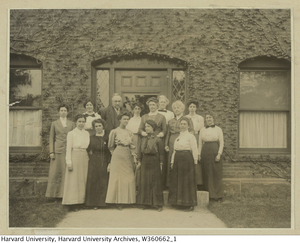
Earliest source: "Observatory Group [photographic group portrait, ca. 1910]." Harvard University Archives / HUPSF Observatory (14). Harvard Libraries, olvwork360662
Harvard calls this photo "Observatory Group", ca. 1910. The Internet often calls it a photo of "Pickering's Harem". I think it's from mid-1911. The lack of Williamina Fleming certainly makes it likely to be after 1911 when she passed away, and Henrietta Leavitt, also absent from the photo, was out of town until late 1911. The photo was taken in the front of the Astrophotographic Library aka, the "Brick Building", aka "Building C."
"Pickering's Harem" may be a modern sexist invention rather than a historic one. I've found no references earlier than 1976 for this phrase. On the other hand, they were much more polite about what the wrote down back then, so it may just as well be a real nickname passed down by oral tradition.
One source that DOES use that nickname, from 1982, also lists a very detailed description of the women in this photo, which I'll just quote here directly:
"At the far left of the photograph is Margaret Harwood (AB Radcliffe 1907, MA University of California 1916), who had just completed her first year as Astronomical Fellow at the Maria Mitchell Observatory. She was later appointed director there, the first woman to be appointed director of an independent observatory. Beside her in the back row is Mollie O'Reilly, a computer from 1906 to 1918. Next to Pickering is Edith Gill, a computer since 1889. Then comes Annie Jump Cannon (BA Wellesley 1884), who at that time was about halfway through classifying stellar spectra for the Henry Draper Catalogue. Behind Miss Cannon is Evelyn Leland, a computer from 1889 to 1925. Next is Florence Cushman, a computer since 1888. Behind Miss Cushman is Marion Whyte, who worked for Miss Cannon as a recorder from 1911 to 1913. At the far right of this row is Grace Brooks, a computer from 1906 to 1920. Ahead of Miss Harwood in the front row is Arville Walker (AB Radcliffe 1906), who served as assistant from 1906 until 1922. From 1922 until 1957 she held the position of secretary to Harlow Shapley, who succeeded Pickering as Director. The next woman may be Johanna Mackie, an assistant from 1903 to 1920. She received a gold medal from the American Association of Variable Star Observers (AAVSO) for discovering the first nova in the constellation of Lyra. In front of Pickering is Alta Carpenter, a computer from 1906 to 1920. Next is Mabel Gill, a computer since 1892. And finally, Ida Woods (BA Wellesley 1893), who joined the corps of women computers just after graduation. In 1920 she received the first AAVSO nova medal; by 1927, she had seven bars on it for her discoveries of novae on photographs of the Milky Way."pickeringsharem
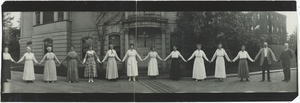
Earliest source: "[Observatory Staff in "paper doll" pose, (in line holding hands) panoramic photograph ca. 1918]." Harvard University Archives / UAV 630.271 (391). Harvard Libraries, olvwork432043
From left to right (primary identifications come from Harvard, who says the names were listed on the back):
I believe the correct names for two of these are "Mary H. Vann" and "Dorothy Block".jaavsoharwood Also, I think this is Mabel, not Edith Gill (or the few other labelled photos I've seen so far similarly mislabel the presumed sisters).
For the longest time I didn't know where pictures like this one were taken. This is an addition to the director's residence added in about 1893 that maybe doubled the size of the residence. The building is not curved, and the brick building to the right is the end of the astrophotographic addition, lying in the same plane. The wide angle just makes it look like a 90 degree bend.
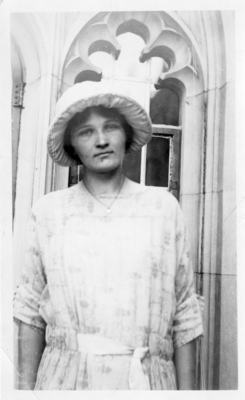
Earliest source: "Cecilia Helena Payne Gaposchkin (1900-1979)." Smithsonian Institution Archives. 26 [retrieved] August 2015.sia2009-1328
I have no information on when or where these photos were taken (but I did learn about foil traceries and cinquefoil arches). But she seems fairly young, so I'd guess close to the same time as her doctoral thesis.
So about that thesis. The way the story is conventionally told, Ms. Payne discovered that the Sun was mostly made of hydrogen and helium, but THE MAN (Henry Norris Russell) wouldn't let her announce those results. Allegedly because of him she published her hydrogen and helium results as "almost certainly not real". While she did use that quote, the evidence for the rest is lacking - no letters [edit- actually there is one, although there are context issues], no early copy of her thesis. And most importantly she doesn't mention it in her autobiography, even though she is vaguely critical of Russell for other reasons (though overall she respected him deeply as a mentor).
Here's the story as I would tell it (danger - we're venturing strongly into opinion territory). Cecilia Payne published a revolutionary thesis in 1925 called Stellar Atmospheres. What she did was both ground-breaking, and fundamental to all stellar astrophysics that followed. Spectrum analysis was very important in astronomy because it could tell you what stars are made of. But until Cecilia Payne's thesis, what it couldn't do was tell you how much of each element was in the stars. Payne applied new theoretical models in quantum mechanics to the analysis of spectrums to estimate how much of each element was in the stars.
She applied this method, and published the results. And the results show that, wow, stars are almost entirely hydrogen and helium. So why did she say "almost certainly not real" if not for THE MAN? The understanding of science in those days was that everything in the universe was made of the same stuff, which is to say, just like the earth. And up until Payne's thesis, stellar spectra confirmed this - stars were made of the same stuff as the earth. And in fact, setting aside the hydrogen and helium, the rest of Payne's results confirmed this prevailing view - the ratios of elements in the stars matched pretty well with what was on the earth.
So pretend you are a scientist, a real scientist who's work is accepted by and respected by your peers. And you discover something completely unexpected and unexplained. Do you shout a complete change in orthodoxy from the rooftops, or do you publish a very cautious note about your unexpected result? If anything, Payne was brave to include the unexpected results at all, even with the "not real" notation, as there have certainly been other scientists who've simply left out unexpected data points.
This then, is why I don't like the conventional retelling. It belittles Ms. Payne's role of a responsible, professional scientist, simply to make an inappropriate point about THE MAN. If Russell did advise her to add that note, it was good advice, but I prefer to think that she was smart enough and professional enough to have published her results this way anyway.
Also, it encourages us to think of all past men as neanderthals, rather than living, breathing individuals. While sexism in general was certainly much worse then, the astronomical community was an exception, generally accepting of women as respected contributers (no doubt in part because of the legacy of Pickering's women computers). And within that community she'd found an even rarer exception at Harvard Observatory, with a small group of men and women who were actually encouraging women to advance as equals.
[But read part II in the next picture]
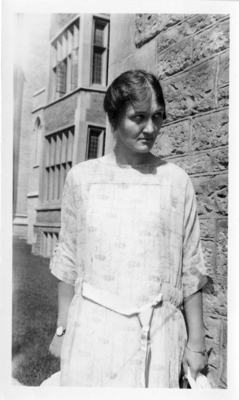
Earliest source: "Cecilia Helena Payne Gaposchkin (1900-1979)." Smithsonian Institution Archives. 26 [retrieved] August 2015.sia2009-1327
[continuing opinions from previous picture]
Of course, having said all that great stuff in defense of men of that era, it was only a small bubble she was in. All the friction outside that bubble held her and all women back. Let's look at THE MAN from that story. Her Mentor, Henry Norris Russell, was not at Harvard, but rather at Princeton. Russell credits his math skills to his mother and grandmother, and he also helped Annie Jump Cannon get one of her honorary degrees, so really not THE MAN he's supposed to be in the popular narrative. But Russell sent his own promising grad student to study at Harvard, Donald Menzel. He did this for the same reason everybody did research at Harvard - their amazing collection of astrophotography and spectra. But in some sense, this also put Menzel in competition with Payne as they were doing very similar research. To avoid trouble Payne's advisor (and director of the Observatory), Harlow Shapley, split up the data (I don't remember exactly how). This was for Payne and that was for Menzel.
In a telling turn, and one that resonates with lessons today about men and women competing in the modern world, Payne kept her crayons inside of her lines, but Menzel did not. He studied all the available data. Who made the right choice? I'm not sure, and I think in this particular case it didn't matter terribly much (she published an amazing thesis). However in the long run, Menzel also ended up back at Harvard, and was a director of the Observatory, a position that Payne was never able to attain. But in my opinion this almost certainly had more to do with sexism at Harvard than it did with research choices they made as grad students.
Ultimately as great as Shapley and Russell and others were for her career, there was little they could do to overcome the deeply rooted sexism in the wider world. Nor should I overstate the acceptance within the astronomical community itself. It may have been ahead of the rest of the world, but people are always products of their times. Sexism was inescapable.
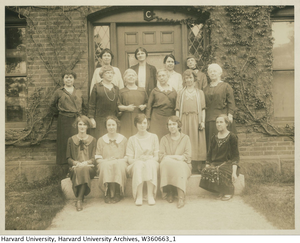
Earliest source: "Observatory Women [photographic group portrait, 1925]." Harvard University Archives / HUPSF Observatory (19). Harvard Libraries, olvwork360663
Harvard says the caption is "As We Were" in the upper left corner, but they must not have scanned that or it is on the back. This is an amazing photo crossing generations of women at Harvard. It's the end of the era of women computers, and the beginning of the era of women scientists.
I found a source identifying the names. Ceclia Payne's expanded autobiography.paynerecollections My guesses were all correct (I skipped five of them).
Back row:
Middle row:
Bottom row:
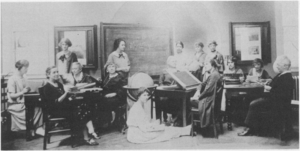
Earliest source: Margaret W. Rossiter. ""Women's Work" in Science, 1880-1910." Isis vol. 71 no. 3. University of Chicago Press, September 1980.womensworksci
Unknown location. (Actually I now believe this may be the west wing of the original building, in the transit room, but after the transit instruments were removed). Source says this photo was taken 19 May, 1925.pickeringsharem
I've only just now noticed that these women are all wearing the exact same outfits as in the other 1925 photo above "As We Were", and so both photos were probably taken on the same day. They appear to be the same set of women, and based on that I've put in the five names I hadn't figured out.
My guesses on identity, left to right:
H. Wilson, A. Maury, A. Hoovens, I. Woods, A. J. Cannon, M. Howe, M. Harwood (on floor), E. Leland, A. Walker, L. Hodgdon, C. Payne (seated), E. F. Gill (standing), M. Walton Mayall, M. Gill, F. Cushman
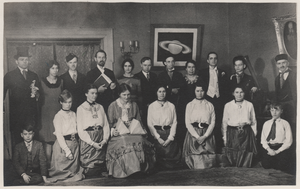
The Cast and Crew of the Observatory Pinafore
A set of six photos of the Observatory Pinfore has recently turned up. They've been scanned by their owner, Charles Reynes, who's the great grandson of Edward Skinner King (who was almost certainly at the performance - he's in the group photo for the AAS conference where the play was staged). They are by far the best quality images I've found anywhere of the performance, and three of them haven't been found anywhere else.
I'm having a particular problem with two identifications from these photographs: G. W. Wheelwright as Winslow Upton and W. R. Ransom as Pickering. I'm hoping to identify the characters from the context of the photos, but at this point I'm not sure that will work. From the opposite end, I've attempted to find photographs of both Wheelwright and Ransom in other contexts. Neither seems to look at all like the character in the photos with the more recessed chin.
Identifications:
Bart J. Bok, unknown women, unknown man, [Wheelwright or Ransom], unknown woman, Harlow Shapley, [Ransom or Wheelwright], Arville Walker, Peter M. Millman, Arthur R. Sayer, Leon Campbell
unknown boy, Mildred Shapley, Adelaide Ames, Cecilia Payne (Gaposchkin), Henrietta Swope, Sylvia Mussels (Lindsay), Helen Sawyer (Hogg), unknown boy
Use/Copyright: Copyright held by Charles Reynes, used here with permission
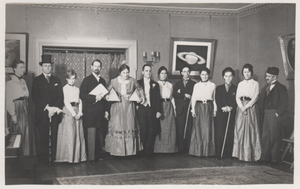
The cast of the Observatory Pinafore
Identifications:
Adelaide Ames (as Rhoda G. Saunders), Bart J. Bok (as Leonard Waldo), Mildred Shapley (as computer), Unknown, Cecilia Payne (as Josephina McCormack), Peter M. Millman (as William Augustus Rogers), Henrietta Swope (as computer), Unknown, Helen Sawyer (as computer), Arthur R. Sayer (as F. E. Seagrave), Sylvia Mussels (as computer), Leon Campbell (as Arthur Searle).
Use/Copyright: Copyright held by Charles Reynes, used here with permission

A scene from the Observatory Pinafore performance, perhaps dancing.
Identifications
Bart J. Bok, Adelaide Ames, Unknown, Leon Campbell, Cecilia Payne, Peter Millman
Use/Copyright: Copyright held by Charles Reynes, used here with permission
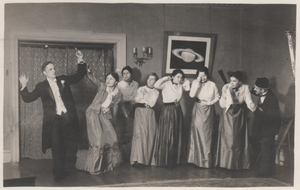
A scene in Observatory Pinafore, where Josephina stops Professor Rogers from killing himself in despair over the defection of his helpful assistant, and circle reader, and whatever else.
This image is the most widely available image of the performance.
Identifications:
Peter Millman, Cecilia Payne-Gaposchkin, Henrietta Swope, Mildred Shapley (daughter of Harlow and Martha Shapeley), Helen Sawyer-Hogg, Sylvia Mussells-Lindsay, Adelaide Ames, Leon Campbell.
These identifications come from the copy of this picture in the Emilo Segre Visual Archive. I've based some of my own identifcations on this list. This is my only source for Mildred Shapley and Sylvia Mussels, all the other faces I've found in other photos (to varying degrees of a satisfactory match, but at least enough of a match to improve my confidence that they're correct).
Use/Copyright: Copyright held by Charles Reynes, used here with permission

A scene from the Observatory Pinafore where Josephina is being pulled away from Professor Rogers by Seagrave and the men of Providence.
I believe this is the point in the play where Josephina is led to the "dungeon".
Identifications:
Unknown, Bart J. Bok, Unknown, Arthur Sayer, Cecilia Payne, Henrietta Swope, Mildred Shapley, Helen Sawyer, Sylvia Mussels, Adelaide Ames.
Use/Copyright: Copyright held by Charles Reynes, used here with permission
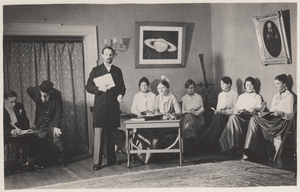
A scene from Observatory Pinfore, with Astronomers and Computers hard at work. Based on the people (and the books), this may be somewhere in the first scene of the play. If so, this could be the Winslow Upton character standing, as the right set of people are on stage for Upton's reciting of "I know the value of a kindly chorus..."
The portrait of Galileo hanging on the right still hangs in the Observatory today; it is the copy by Carlton gifted in 1890.
Identifications
Use/Copyright: Copyright held by Charles Reynes, used here with permission
 Fine's Home
Fine's Home